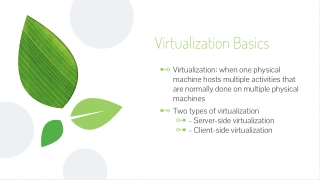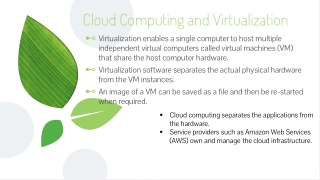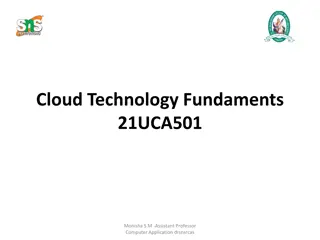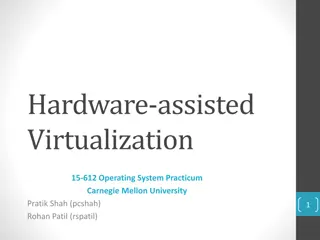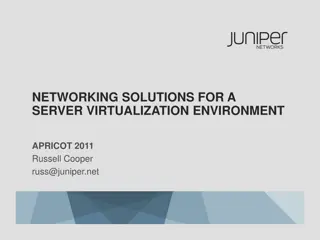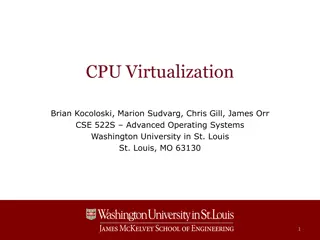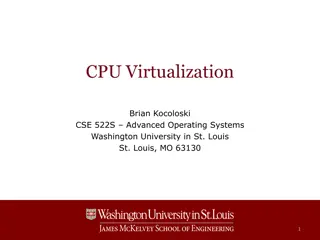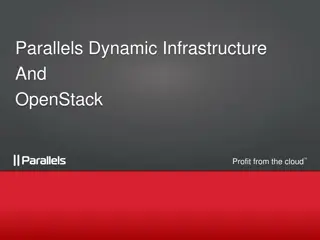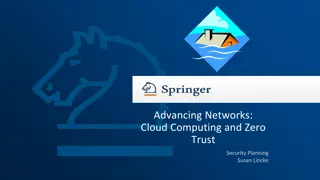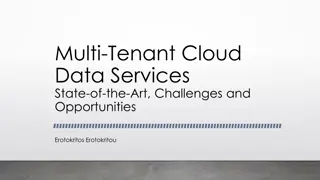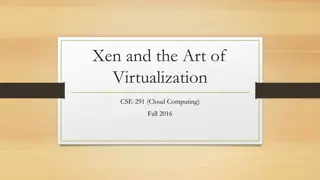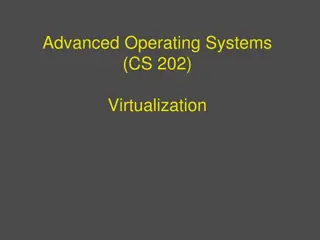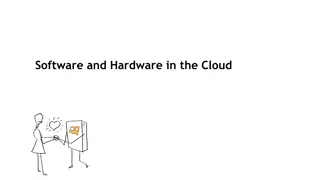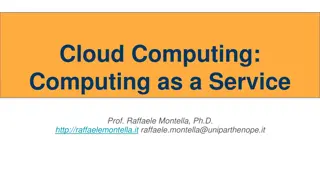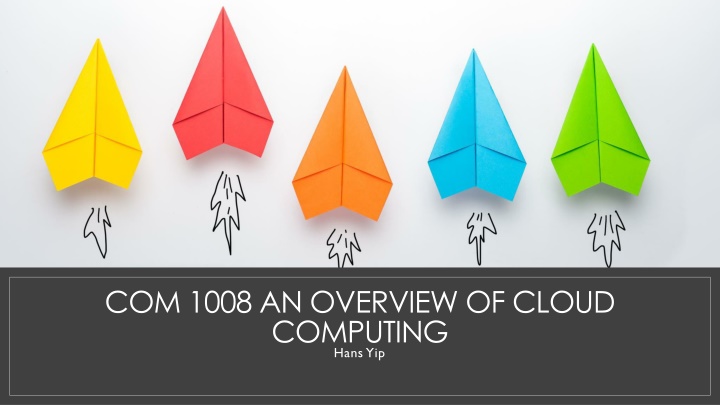
Overview of Cloud Computing: Virtualization Benefits & Infrastructure Management
Cloud computing overview focusing on virtualization technologies, benefits, and infrastructure management. Details on server consolidation, resource management, and enabling technologies for efficient operations.
Download Presentation

Please find below an Image/Link to download the presentation.
The content on the website is provided AS IS for your information and personal use only. It may not be sold, licensed, or shared on other websites without obtaining consent from the author. If you encounter any issues during the download, it is possible that the publisher has removed the file from their server.
You are allowed to download the files provided on this website for personal or commercial use, subject to the condition that they are used lawfully. All files are the property of their respective owners.
The content on the website is provided AS IS for your information and personal use only. It may not be sold, licensed, or shared on other websites without obtaining consent from the author.
E N D
Presentation Transcript
COM 1008 AN OVERVIEW OF CLOUD COMPUTING Hans Yip
Learning Objectives Introduction Virtualization for Cloud Computing What is virtualization? Benefits of virtualization Types of virtualization What is virtual machine? Process virtual machine System virtual machine Hardware level virtualization: Hardware-assisted virtualization OS-level virtualization: Homogeneous environment Software level virtualization: Hypervisor types (Full virtualization, Para-virtualization); implementation approaches (type I/Bare metal, type II/hosted approach) What is server virtualization? What is hypervisor/virtual machine monitor (VMM)? Binary translation and direct execution Sample hypervisor: Vmware ESXI, Citrix Xen server, Ubuntu KVM
Virtualization for Cloud Computing Virtualization is the enabling technology and creates virtual machines that allows a single machine to act as if it were many machines. Benefits of virtualization for cloud computing: Reduces capital expenses and maintenance costs through server consolidation, reduces physical space needed in data centers. Resource Management, Migration, Maintainability, High availability and Fault tolerance are other benefits. [Copied from Virtualization for Cloud Computing ,Dr.SanjayAhuja,PhD (University of North Florida)]
What is Virtualization The term virtualization broadly describes the separation of a resource or request for a service from the underlying physical delivery of that service. With virtual memory, for example, computer software gains access to more memory than is physically installed, via the background swapping of data to disk storage. Similarly, virtualization techniques can be applied to other IT infrastructure layers - including networks, storage, laptop or server hardware, operating systems and applications. [Copied from VMWare Virtualization.pdf]
Virtual Infrastructure This blend of virtualization technologies - or virtual infrastructure - provides a layer of abstraction between computing, storage and networking hardware, and the applications running on it. The deployment of virtual infrastructure is non-disruptive, since the user experiences are largely unchanged. However, virtual infrastructure gives administrators the advantage of managing pooled resources across the enterprise, allowing IT managers to be more responsive to dynamic organizational needs and to better leverage infrastructure investments. [Copied from VMWare Virtualization.pdf]
Benefits of Virtual Infrastructure Server Consolidation and Containment Eliminating server sprawl via deployment of systems as virtual machines (VMs) that can run safely and move transparently across shared hardware, and increase server utilization rates from 5-15% to 60-80%. Test and Development Optimization Rapidly provisioning test and development servers by reusing pre-configured systems, enhancing developer collaboration and standardizing development environments. Business Continuity Reducing the cost and complexity of business continuity (high availability and disaster recovery solutions) by encapsulating entire systems into single files that can be replicated and restored on any target server, thus minimizing downtime. Enterprise Desktop Securing unmanaged PCs, workstations and laptops without compromising end user autonomy by layering a security policy in software around desktop virtual machines. [Copied from VMWare Virtualization.pdf]
Why Virtualization? Lots of servers: Web servers Mail servers Database servers File servers Proxy servers Application servers and many others, etc [Copied from Virtualization Techniques for Cloud Computing , Prof Chih-Hung Wu (National University of Kaohsiung)]
Why Virtualization? Problems caused by lots of servers: The data-center is FULL Full of under-utilized servers Complicated in management Power consumption Greater wattage per unit area than ever Electricity overload Cooling at capacity Environmental problem Green IT [Copied from Virtualization Techniques for Cloud Computing , Prof Chih-Hung Wu (National University of Kaohsiung)]
Why now? Hardware evolution Faster CPU clock than ever More CPU cores in a single chip 4-core CPU already in the market 6- or 8- core CPUs will be there soon Multi-core architectures make parallel processing more realizable Virtualization support on chip from CPU manufacturers (Intel VT-x; AMD s AMD-V) Software maturity Available and stable open-sourced software OS, DB, Web server, Java, PHP, gcc, etc Established and mature software standards Web service, XML, SOAP, COM, etc [Copied from Virtualization Techniques for Cloud Computing , Prof Chih-Hung Wu (National University of Kaohsiung)]
Types of Virtualization Virtual memory Desktop virtualization Platform virtualization (Server virtualization) Full virtualization Paravirtualization Hardware-assisted virtualization Partial virtualization OS-level virtualization Hosted environment (e.g. User-mode Linux) Resource virtualization: Storage virtualization Network virtualization Application virtualization/Portable application Cross-platform virtualization Emulation or simulation Hosted Virtual Desktop [Copied from Virtualization Techniques for Cloud Computing , Prof Chih-Hung Wu (National University of Kaohsiung)]
What is a Virtual Machine? A virtual machine, known as a guest, is a software computer (emulation of a computer system) that provide the same functionality as physical computer. There are two types of virtual machines: Process Layer (Virtual Machine), AKA Application Virtual Machine: Execute computer programs in a platform- independent environment. It masks the information of the underlying hardware or operating system. This allows the program to be executed in the same fashion on any platform. (e.g. Java interpreter executes Java byte code) System Layer (Virtual Machine): Support the sharing of a host computer s physical resources between multiple virtual machines. (grew out of time-sharing, IBM CP/CMS, CP-40, System 360 in 1963 - simulation) Hardware Level Virtualization: Hardware-assisted Virtualization (IBM mainframe, x86 processors) OS-level Virtualization: does not use hypervisor, host O/S acts as hypervisor Software Level (High-level Language) Virtualization: Hosted approach and Hypervisor (Bare metal) approach [https://en.m.wikipedia.org/wiki/Virtual_machine] [https://www.vmware.com/topics/glossary/content/virtual-machine]
Hardware Level Virtualization Hardware-assisted virtualization: the hardware provides architectural support that facilitates building a virtual machine monitor and allows guest OSes to be run in isolation.[19] Hardware-assisted virtualization was first introduced on the IBM System/370 in 1972,for use withVM/370, the first virtual machine operating system offered by IBM as an official product. In 2005 and 2006,Intel andAMD provided additional hardware to support virtualization. Sun Microsystems (now Oracle Corporation) added similar features in their UltraSPARC T- Series processors in 2005. Examples of virtualization platforms adapted to such hardware include KVM,VMware Workstation,VMware Fusion,Hyper-V,Windows Virtual PC,Xen,Parallels Desktop for Mac,Oracle VM Server for SPARC,VirtualBox and Parallels Workstation.
Operating-system Level Virtualization OS-Level Virtualization (homogeneous environment): a physical server is virtualized at the operating system level, enabling multiple isolated and secure virtualized servers to run on a single physical server. The "guest" operating system environments share the same running instance of the operating system as the host system. Thus, the same operating system kernel is also used to implement the "guest" environments, and applications running in a given "guest" environment view it as a stand-alone system. The pioneer implementation was FreeBSD jails; other examples include Docker,Solaris Containers,OpenVZ,Linux-VServer,LXC, AIXWorkload Partitions, Parallels Virtuozzo Containers, and iCoreVirtual Accounts.
Software Level Virtualization High-level Language Virtualization: use of Hypervisors Hypervisor Types: Full Virtualization: Full virtualization uses a hypervisor, a type of software that directly communicates with a physical server's disk space and CPU. (No modification of guest OS) Para-virtualization: The modification of the source code of an OS in order to run as a guest OS in a virtual machine (VM) environment. Calls to the hardware from the guest OS are replaced with calls to the VM monitor (VMM). Several operating systems, such as Linux, OpenBSD, FreeBSD and OpenSolaris, were paravirtualized for the Xen VM monitor (see Xen). Hypervisor implementation approaches: Hypervisor approach (native or bare metal approach) (type 1 hypervisor): a hypervisor architecture is the first layer of software installed on a clean x86-based system (hence it is often referred to as a bare metal approach). Since it has direct access to the hardware resources, a hypervisor is more efficient than hosted architectures, enabling greater scalability, robustness and performance. Hosted approach (type II hypervisor): A hosted approach provides partitioning services on top of a standard operating system and supports the broadest range of hardware configurations.
Only Focus on Platform/Server Virtualization In this course we mainly focus on Platform virtualization which is mostly related to cloud-computing Full virtualization Binary translation Hardware-assisted virtualization Paravirtualization OS-level virtualization Hosted environment (e.g. User-mode Linux) [Copied from Virtualization Techniques for Cloud Computing , Prof Chih-Hung Wu (National University of Kaohsiung)]
What is Server Virtualization? Server virtualization is used to mask server resources from server users. This can include the number and identity of operating systems, processors, and individual physical servers. [https://www.vmware.com /topics/glossary/content/se rver-virtualization]
Server Virtualization Definition Server virtualization is the process of dividing a physical server into multiple unique and isolated virtual servers by means of a software application. Each virtual server can run its own operating systems independently. [https://www.vmware.com/topics/glossary/content/server- virtualization]
Three Kinds of Server Virtualization Full Virtualization: Full virtualization uses a hypervisor, a type of software that directly communicates with a physical server's disk space and CPU. The hypervisor monitors the physical server's resources and keeps each virtual server independent and unaware of the other virtual servers. It also relays resources from physical server to the connect virtual server as it runs applications. The biggest limitation of using full virtualization is that a hypervisor has its own processing needs. This can slow down applications and impact server performance. Para-Virtualization: Unlike full virtualization, para-virtualization involves the entire network working together as a cohesive unit. Since each operating system on the virtual servers is aware of one another in para- virtualization, the hypervisor does not need to use as much processing power to manage the operating systems. OS-Level Virtualization: Unlike full and para-virtualization, OS-level visualization does not use a hypervisor. Instead, the virtualization capability, which is part of the physical server operating system, performs all the tasks of a hypervisor. However, all the virtual servers must run that same operating system in this server virtualization method. [https://www.vmware.com/topics/glossary/content/server-virtualization]
What is a Hypervisor /Virtual Machine Monitor (VMM)? Hypervisor plays an important role in the virtualization scenario by virtualization of hardware. It provides support for running multiple operating systems concurrently in virtual servers created within a physical server. The virtualization layer is the software responsible for hosting and managing all VMs. The virtualization layer is a hypervisor running directly on the hardware. Example: VMWare, Xen, KVM. [Copied from Virtualization for Cloud Computing , Dr. Sanjay Ahuja, PhD (University of North Florida)]
Full Virtualization Enables hypervisors to run an unmodified guest operating system (e.g. Windows 2003 or XP). Guest OS is not aware that it is being virtualized. E.g.: VMware uses a combination of direct execution and binary translation techniques to achieve full virtualization of server systems. [Copied from Virtualization for Cloud Computing , Dr. Sanjay Ahuja, PhD (University of North Florida)]
Para- Virtualization Para virtualization Involves explicitly modifying guest operating system (e.g. SUSE Linux Enterprise Server 11) so that it is aware of being virtualized to allow near native performance. Improves performance. Lower overhead. E.g.: Xen supports both Hardware Assisted Virtualization (HVM) and Para-Virtualization (PV). Oracle VM is built upon Xen technology, using the Xen hypervisor. [Copied from Virtualization for Cloud Computing , Dr. Sanjay Ahuja, PhD (University of North Florida)]
OS-Level Virtualization OS-level virtualization kernel of an OS allows for multiple isolated user-space instances, instead of just one. Each OS instance looks and feels like a real server [Copied from Virtualization Techniques for Cloud Computing , Prof Chih- Hung Wu (National University of Kaohsiung)]
Two Hypervisor Implementation approaches Hypervisor approach (native or bare metal approach) (type I hypervisor): a hypervisor architecture is the first layer of software installed on a clean x86- based system (hence it is often referred to as a bare metal approach). Since it has direct access to the hardware resources, a hypervisor is more efficient than hosted architectures, enabling greater scalability, robustness and performance. Hosted approach (type II hypervisor): a hosted approach provides partitioning services on top of a standard operating system and supports the broadest range of hardware configurations.
Bare Metal Approach (Type I hypervisor) Type I Hypervisor. Runs directly on the system hardware. May require hardware assisted virtualization technology support by the CPU. Limited set of hardware drivers provided by the hypervisor vendor. E.g.: Xen, VMWare ESXi
Hosted Approach (Type II hypervisor) Type II Hypervisor. Runs virtual machines on top of a host OS (windows, Unix etc.) Relies on host OS for physical resource management. Host operating system provides drivers for communicating with the server hardware. E.g.: VirtualBox
Binary Translation and Direct Execution Binary translation. Binary translation is one specific approach to implementing full virtualization that does not require hardware virtualization features. It involves examining the executable code of the virtual guest for "unsafe" instructions, translating these into "safe" equivalents, and then executing the translated code. Alternatives to binary translation are binary patching, and full system emulation. Direct execution. This is a mode that can be combined with binary translation. With direct execution, most code is executed directly on the CPU, and only the code that needs to be translated is actually translated. [https://blogs.oracle.com/ravello/nest ed-virtualization-with-binary- translation]
Virtualization References https://www.vmware.com/pdf/virtualization.pdf https://searchvmware.techtarget.com/definition/VMware https://www.vmware.com/topics/glossary/content/virtual-machine https://www.vmware.com/topics/glossary/content/server-virtualization https://www.pcmag.com/encyclopedia/term/59102/paravirtualization https://computer.howstuffworks.com/server-virtualization2.htm https://www.geeksforgeeks.org/types-of-server-virtualization-in-computer-network/ https://www.vmware.com/pdf/virtualization.pdf https://www.w3schools.in/cloud-computing/cloud-computing/# https://searchservervirtualization.techtarget.com/definition/hardware-assisted-virtualization https://docs.oracle.com/cd/E26996_01/E18549/html/VMUSG1010.html https://en.m.wikipedia.org/wiki/Hardware-assisted_virtualization https://en.m.wikipedia.org/wiki/Virtual_machine
VMware ESXI VM VM VM Bare Metal Approach. Full virtualization. Proven technology. Used for secure and robust virtualization Hypervisor solutions for virtual data centers and cloud Hardware infrastructures. Takes advantage of support for hardware assisted virtualization for 64-bit OS on Intel processors.
Citrix Xen Server Open source; bare metal. Offers both Hardware Assisted Virtualization (HVM) and Para-Virtualization (PV) Needs virtualization support in the CPU for HVM. Xen loads an initial OS which runs as a privileged guest called domain 0 . The domain 0 OS, typically a Linux or UNIX variant, can talk directly to the system hardware (whereas the other guests cannot) and also talk directly to the hypervisor itself. It allocates and maps hardware resources for other guest domains. Domain Zero Guest VM VM Hypervisor Hardware
Ubuntu KVM Kernel based virtual machine (Kernel Based VM) Open source. Kernel-level extension to Linux. Full virtualization. Supports full virtualization and hence does not need hardware assisted virtualization support in the CPU. [https://www.linux-kvm.org/page/Main_Page] 1. Linux Applications 2. KVM Management Console VM VM Linux KVM Linux Kernel Hardware
Ubuntu KVM KVM uses Qemu software for emulating the hardware. People assume it is a type 2 hypervisor because one of the ways that it is packaged is as a component of Linux - so you can be running a Linux distribution and then, from the command-line shell prompt or from a graphical user interface on that Linux box, you can start KVM. The interface makes it look like it is a hosted hypervisor running on the operating system, but the virtual machine is running on the bare metal - the host operating system provides a launch mechanism for the hypervisor and then engages in a co-processing relationship with the hypervisor. In a sense, it is taking over part of the machine and sharing it with the Linux kernel. On x86 hardware, KVM relies on the hardware virtualization instructions that have been in these processors for seven years. Using these instructions the hypervisor and each of its guest virtual machines run directly on the bare metal, and most of the resource translations are performed by the hardware. The SUSE Linux Enterprise Virtual Machine Driver Pack contains 32-bit and 64-bit paravirtualized network, bus and block drivers for a number of Microsoft Windows operating systems (including Windows XP*, Windows Server* and Windows 7*). These drivers bring many of the performance advantages of paravirtualized operating systems to unmodified operating systems because only the paravirtualized device driver (not the rest of the operating system) is aware of the virtualization platform. For example, a paravirtualized disk device driver appears as a normal, physical disk to the operating system. However, the device driver interacts directly with the virtualization platform (with no emulation) to efficiently deliver disk access, allowing the disk and network subsystems to operate at near native speeds in a virtualized environment, without requiring changes to existing operating systems.
Questions What is Virtualization? What are the benefits of virtualization? What are the causes of virtualization? What are the types of virtualization? What is Virtual Machine, and what are the types of VM? What is software level virtualization? How many types of hypervisor? What is binary translation, and direct execution? What is Vmware ESXI, Centrix XEN server, Ubuntu KVM?

